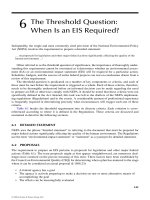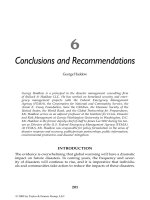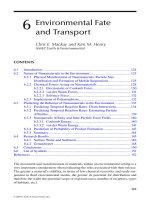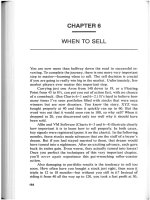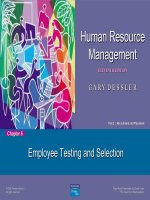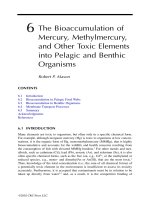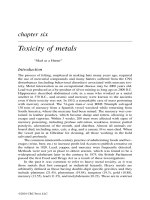Estuarine Research, Monitoring, and Resource Protection - Chapter 6 pdf
Bạn đang xem bản rút gọn của tài liệu. Xem và tải ngay bản đầy đủ của tài liệu tại đây (877.05 KB, 16 trang )
Case Study 5
1960_book.fm Page 215 Friday, August 15, 2003 1:37 PM
Copyright © 2004 CRC Press, LLC
217
6
Weeks Bay National
Estuarine Research Reserve
INTRODUCTION
Weeks Bay was designated as a National Estuarine Research Reserve site in 1986.
Covering an area of ~2400 ha, the Weeks Bay National Estuarine Research Reserve
(Weeks Bay NERR) encompasses a variety of watershed and estuarine habitats,
including upland forests, maritime and palustrine plant communities, swamps, fresh-
water marshes, salt marshes, tidal ßats, and open estuarine waters and bay bottom.
Uplands and tidelands cover nearly 80% of the reserve area.
The Weeks Bay NERR is one of three active NERR sites in the Gulf of Mexico
region; the other two are Rookery Bay NERR near Naples, Florida (designated in
1978), and Apalachicola NERR at Apalachicola, Florida (designated in 1979). It is
located in Baldwin County, Alabama, an area known during the past century for its
agriculture and silviculture industries. Timber production remains an important
industry, with several paper companies operating in the region. Forested habitat —
pine-rich woodlands — represents a major land use category in the county. Farmland
also constitutes a major land use category. Residential development accounts for a
rather small percentage (<2%) of the total land area of Baldwin County, although a
signiÞcant increase in the amount of developed land surrounding Weeks Bay is
anticipated during the next decade (Arcenaux, 1996).
Weeks Bay is a small estuary and hence may be more susceptible to anthropogenic
activities in adjoining watershed areas. However, despite considerable agriculture and
silviculture in the watershed, no evidence exists of acute pollution or extensive habitat
impacts in the bay (Lytle and Lytle, 1995; Lytle et al., 1995; Valentine and Lynn, 1996).
Nevertheless, more data must be collected on the effects of anthropogenic activities
on the biotic communities and habitats of the estuary. Currently, only a limited database
has been compiled on this subject area, and more information must be obtained before
deÞnitive assessment of the system can be completed.
WEEKS BAY
P
HYSICAL
D
ESCRIPTION
Miller-Way et al. (1996) have conducted a detailed investigation of the physical–chem-
ical and biological characteristics of Weeks Bay. With a surface area of only ~7
¥
10
6
m
2
and an average depth of less than 2 m (Crance, 1971; Schroeder et al., 1992), the
bay is a tributary estuary of Mobile Bay (Schroeder, 1996). It is one of the smallest
estuaries in the NERR system, measuring less than 4 km in length and width. Located
along the eastern shore of Mobile Bay, Weeks Bay is oriented with its long axis trending
1960_book.fm Page 217 Friday, August 15, 2003 1:37 PM
Copyright © 2004 CRC Press, LLC
218
Estuarine Research, Monitoring, and Resource Protection
north–south such that hydrologic communication with Mobile Bay occurs through a
narrow inlet at the mouth of the bay in the southern perimeter (Figure 6.1). Weeks
Bay is a microtidal estuary characterized by diurnal tides with a range of 0.4 m.
Currents at the mouth of the bay exceed 1 m/sec, but they decline appreciably within
the bay to less than half of this value (Schroeder et al., 1990).
Most freshwater enters Weeks Bay via discharges from the Fish River and
Magnolia River with a combined ßow of ~9 m/sec. The Fish River, which ßows
into the northern bay, delivers nearly 75% of the total freshwater input. Much of
this freshwater input ßows southward along the bay’s western perimeter. Water
entering the bay at its mouth from Mobile Bay ßows northward along the eastern
margin, thereby creating essentially a counterclockwise circulation pattern. Fresh-
water discharge from the Magnolia River enters about midway along the eastern
shore of Weeks Bay, and it mixes with the northward-ßowing Mobile Bay water
(Schroeder et al., 1990; Schroeder, 1996).
The salinity regime is highly variable in Weeks Bay because of the salinity ßux
of Mobile Bay water entering at its mouth, as well as changes in the volume of
freshwater discharges from the Fish and Magnolia Rivers. In addition, variable wind
FIGURE 6.1
Map of Weeks Bay showing bathymetric contours. (From Schroeder, W.W., S.P.
Dinnel, and W.J. Wiseman, Jr. 1992. Salinity structure of a shallow tributary estuary. In: D.
Prandle (Ed.).
Dynamics and Exchanges in Estuaries and the Coastal Zone.
Vol. 40, Coastal
and Estuarine Studies, American Geophysical Union, Washington, D.C., pp. 155–171.)
1960_book.fm Page 218 Friday, August 15, 2003 1:37 PM
Copyright © 2004 CRC Press, LLC
Weeks Bay National Estuarine Research Reserve
219
and tidal conditions contribute to shifts in the temporal and spatial salinity structure
of Weeks Bay. Hence, salinities in the bay generally range from near 0 to ~20‰,
with horizontal salinity gradients varying from weak to strong depending on the
aforementioned freshwater inputs and salinity of Mobile Bay water. The vertical
salinity structure likewise is variable; both well-mixed and strongly stratiÞed con-
ditions have been documented in the bay (Schroeder et al., 1992).
Water depths are generally deeper in the lower bay (~2–3 m) than in the upper
bay (1 m or less) as shown in Figure 6.1. The deepest areas (3–4 m) occur at the mouth
of the bay and probably reßect the effects of tidal current scour. An even deeper
bathymetric depression (~5–7 m) lies immediately upstream of the Fish River mouth
(Schroeder, 1996). Sediments are actively accumulating in Weeks Bay, particularly
along the western side (Hardin et al., 1976), and thus the long-term bathymetric
condition appears to be one of shoaling. Most of the bottom sediments in the bay
consist of a mixture of silts and clays (Figure 6.2). However, sand predominates at the
mouth of the bay and in a relatively narrow band abutting the shoreline and surrounding
much of the periphery of the bay. A tongue-like mass of sandy sediment also extends
about 1 km into the bay from the western bank of the Fish River at its mouth. Sediment
in the bay largely derives from the Fish and Magnolia Rivers. Some of the sediment
in the area of the bay mouth originates from Mobile Bay (Haywick et al., 1994).
FIGURE 6.2
Sediment distribution and composition in Weeks Bay. (From Haywick, D.W.,
W.F. Geers, and M.D. Cooper. 1994. Preliminary Report of Grain Size Distribution in Weeks
Bay, Baldwin County, Alabama. Technical Report, National Estuarine Research Reserve,
Silver Spring, MD.)
1960_book.fm Page 219 Friday, August 15, 2003 1:37 PM
Copyright © 2004 CRC Press, LLC
220
Estuarine Research, Monitoring, and Resource Protection
WATERSHED
P
LANT
C
OMMUNITIES
Upland Habitats
Upland pine forests provide valuable habitat for herpetofauna, mammals, birds, and
other animals in the Weeks Bay watershed. Loblolly pine (
Pinus taeda
), long leaf
pine (
P. palustris
), and slash pine (
P. elliottii
) occur in this coastal plain habitat.
The eastern red cedar (
Juniperus virginiana
), white oak (
Quercus alba
), laurel oak
(
Q. laurifolia
), and live oak (
Q. virginiana
) are also found in these forests, along
with other species of hardwood trees (Miller-Way et al., 1996).
Wetland Habitats
Stout (1987) showed that palustrine forested wetlands (bottomland hardwood swamps)
are the dominant emergent habitat of the reserve, comprising nearly 90% of the mapped
area. The canopy vegetation in this habitat consists primarily of pine trees (long leaf
pine and slash pine) and various broadleaved deciduous trees (e.g., red maple,
Acer
rubrum
; sweetbay,
Magnolia virginiana
; and swamp tupelo,
Nyssa sylvatica
var.
bißora
). The subcanopy includes robust species such as hollies (
Ilex
spp.) and Virginia
willow (
Itea virginica
). Under this shrub subcanopy is a plush herbaceous ground
cover layer consisting of poison ivy (
Toxicodendrom radicans
), ferns (royal fern,
Osmunda regalis
; and cinnamon fern,
O. cinnamomea
), and sundews (
Drosera
spp.).
Palustrine marshes are much less extensive than palustrine forested wetlands,
covering less than 1% of the total Weeks Bay NERR habitat area. They typically
concentrate in limited patches near the mouths of small streams. Among the species
of plants growing in this habitat are the cattail (
Typha angustifolia
), common reed
(
Phragmites australis
), saw grass (
Cladium jamaicense
), alligator weed (
Alter-
nathera philoxeroides
), pickerel weed (
Ponderia cordata
), arrow arum (
Peltandra
virginica
), and arrow leaf (
Sagittaria lancifolia
) (Stout, 1996).
The black needlerush (
Juncus roemerianus
) dominates salt marsh biotopes along the
bay. Species of secondary abundance are the giant cordgrass (
Spartina cynosuroides
),
which inhabits brackish areas near the head of the bay, and the smooth cordgrass (
S.
alternißora
), which concentrates near the mouth of the bay. Moving up the marsh, the
salt meadow cordgrass (
S. patens
) and salt grass (
Distichlis spicata
) appear and eventually
give way at higher elevations to sea myrtle (
Baccharus halmifolia
) and marsh elder (
Iva
frutescens
) in irregularly ßooded habitat (Stout and Lelong, 1981; Stout, 1996).
A
NIMAL
C
OMMUNITIES
Herpetofauna
Watershed habitats in the Weeks Bay NERR support nearly 50 species of amphibians
and reptiles (Table 6.1). Marion and Dindo (1987, 1988) determined that the her-
petofaunal community inhabiting the reserve is relatively rich, especially bordering
the Fish and Magnolia Rivers. Amphibians are represented by an array of frogs,
toads, salamanders, and amphiumas. Pine snakes, mud snakes, king snakes, and
1960_book.fm Page 220 Friday, August 15, 2003 1:37 PM
Copyright © 2004 CRC Press, LLC
Weeks Bay National Estuarine Research Reserve
221
TABLE 6.1
Herpetofaunal Species That Occur or Are Likely to Occur
in the Weeks Bay National Estuarine Research Reserve
Common Name Scientific Name
Amphibians
One-toed amphiuma
Amphiuma pholeter
Two-toed amphiuma
Amphiuma means
Three-toed amphiuma
Amphiuma tridactylum
Bronze frog
Rana clamitans clamitans
Bullfrog
Rana catesbeina
Dusky gopher frog
Rana aureolata sevosa
Pig frog
Rana grylio
River frog
Rana heckscheri
Southern leopard frog
Rana pipiens sphenocephala
Southern chorus frog
Pseudacris nigrita
Southern cricket frog
Acris gryllus gryllus
Barking treefrog
Hyla gratiosa
Cope’s gray treefrog
Hyla chrysoscelis
Green treefrog
Hyla cinerea
Pine woods treefrog
Hyla femoralis
Squirrel treefrog
Hyla squirella
Northern spring peeper
Hyla crucifer crucifer
Eastern lesser siren
Siren intermedia intermedia
Greater siren
Siren lacertina
Fowler’s toad
Bufo woodhousii fowleri
Oak toad
Bufo quercicus
Southern toad
Bufo terrestris
Narrowmouth toad
Gastrophryne carolinensis
Flatwoods salamander
Ambystoma cingulatum
Mole salamander
Ambystoma talpoideum
Dwarf salamander
Manculus quadridigitatus
Gulf Coast mud salamander
Pseudotriton montanus
Slimy salamander
Plethodon glutinosus
Southern dusky salamander
Desmognathus fuscus auriculatus
Southern red salamander
Pseudotriton ruber vioscai
Two-lined salamander
Eurycea bislineata
Three-lined salamander
Eurycea longicauda
Red-spotted newt
Notopthalmus viridescens
Reptiles
Scarlet king snake
Lampropeltis triangulum
Eastern king snake
Lampropeltis getula getula
Speckled king snake
Lampropeltis getula holbrooki
Pine woods snake
Rhadinaea ßavilata
Black pine snake
Pituophis melanoleucus lodingi
Florida pine snake
Pituophis melanoleucus mugitus
(
continued
)
1960_book.fm Page 221 Friday, August 15, 2003 1:37 PM
Copyright © 2004 CRC Press, LLC
222
Estuarine Research, Monitoring, and Resource Protection
Florida green water snake
Natrix cyclopion ßoridana
Gulf salt marsh water snake
Natrix fasciata clarki
Banded water snake
Nerodia fasciata
Green water snake
Nerodia cyclopion
Yellow-bellied water snake
Nerodia erythrogaster ßavigaster
Water moccasin
Agkistrodon piscivorus
Northern black racer
Coluber constrictor constrictor
Coral snake
Micrurus fulvius
Corn snake
Elaphe guttata guttata
Eastern diamondback
Crotalus adamanteus
Eastern garter snake
Thamnophis sirtalis
Eastern ribbon snake
Thamnophis sauritus sauritus
Eastern indigo snake
Drymarchon corais couperi
Eastern mud snake
Farancia abacura
Rainbow snake
Farancia erytrogramma
Gray rat snake
Elaphe obsoleta spiloides
Ringneck snake
Diadophis punctatus
Rough green snake
Opheodrys aestivus
Eastern glass lizard
Ophisaurus ventralis
Green anole
Anolis carolinensis
Broadheaded skink
Eumeces laticeps
Five-lined skink
Eumeces fasciatus
Ground skink
Scincella lateralis
Six-lined racerunner
Cnemidophorus sexlineatus
Snapping turtle
Chelydra serpentina
Florida softshell turtle
Trionyx ferox
Gulf Coast box turtle
Terrapene carolina major
Atlantic Ridley turtle
Lepidochelys kempii
Loggerhead musk turtle
Sternotherus minor
Stinkpot musk turtle
Sternotherus odoratus
Gopher tortoise
Gopherus polyphemus
Yellow-bellied pond slider
Pseudemys scripta
River cooter
Pseudemys concinna
Florida cooter Pseudemys ßoridana
Alabama red-bellied turtle Pseudemys alabamensis
Alligator snapping turtle Macroclemys temminckii
Mississippi diamondback terrapin Malaclemys terrapin pileata
American alligator Alligator mississippiensis
Source: Miller-Way, T., M. Dardeau, and G. Crozier (Eds.). 1996. Weeks Bay
National Estuarine Research Reserve: An Estuarine ProÞle and Bibliography.
Dauphin Island Sea Lab Technical Report 96–01, Dauphin Island, AL.
TABLE 6.1 (CONTINUED)
Herpetofaunal Species That Occur or Are Likely to Occur
in the Weeks Bay National Estuarine Research Reserve
Common Name Scientific Name
1960_book.fm Page 222 Friday, August 15, 2003 1:37 PM
Copyright © 2004 CRC Press, LLC
Weeks Bay National Estuarine Research Reserve 223
skinks are also common. While some turtles are seasonally abundant (e.g., Gulf
Coast box turtle, Terrapene carolina major), others (e.g., Mississippi diamondback
terrapin, Malaclemys terrapin pileata) rarely appear.
Mammals
The list of mammals recorded in the Weeks Bay NERR is not extensive (<40 species)
(Table 6.2). Marion and Dindo (1987, 1988) characterized the mammalian species
diversity of the reserve as somewhat limited. Dardeau (1996) reported that marsh rabbits
(Sylvilagus palustris) and raccoons (Procyon lotor) dominate the marsh and shoreline
habitats of the reserve. Other common inhabitants include bats (e.g., evening bat,
Nycticeius humeralis), squirrels (e.g., eastern gray squirrel, Sciurus carolinensis), opos-
sums (Didelphis marsupialis), and foxes (e.g., gray fox, Urocyon cinereoargenteus).
Birds
Gulls, cormorants, terns, coots, grebes, kingÞshers, waders, ßycatchers, warblers,
grackles, sparrows, goldÞnches, wrens, doves, plovers, sandpipers, vireos, owls, and
hawks frequent Weeks Bay NERR habitats. All major feeding groups are represented
(i.e., granivores, insectivores, omnivores, herbivores, piscivores, and carnivores).
More than 300 species of birds either occur or are likely to occur in the reserve,
reßecting the importance of its location within the migratory corridor. Marion and
Dindo (1987, 1988), conducting shoreline surveys in the reserve, noted that only six
species of birds were common during all seasons of the year; these included the
laughing gull (Larus atricilla), common tern (Sterna hirundo), least tern (S. antil-
larum), royal tern (S. maxima), great blue heron (Ardea herodias), and belted king-
Þsher (Ceryle alcyon). While coots, cormorants, gulls, grebes, terns, and long-legged
waders were observed in the Weeks Bay area either seasonally or year-round, other
species were rarely (if at all) seen. For example, small wading birds, marsh ducks,
and black skimmers (Rynchops niger) were not registered by these investigators.
Their absence is probably due to either the limited extent of suitable habitat or
insufÞcient food sources for these birds in the reserve (Dardeau, 1996).
ESTUARY
P
LANT COMMUNITIES
Phytoplankton and Microphytobenthos
Schreiber (1994), Schreiber and Pennock (1995), and Pennock (1996) have investigated
the nutrient dynamics and microalgal production of Weeks Bay. They noted that Weeks
Bay is generally nutrient-rich and productive for several reasons, most importantly:
1. Nutrient inputs from the Fish and Magnolia Rivers as well as Mobile Bay
2. Nutrient enrichment from anthropogenic activities in the watershed
3. Shallow water depths enabling light transmission through the water col-
umn to the bay bottom, particularly during the productive summer months
when turbidity is generally low
1960_book.fm Page 223 Friday, August 15, 2003 1:37 PM
Copyright © 2004 CRC Press, LLC
224 Estuarine Research, Monitoring, and Resource Protection
Over an annual cycle, the concentrations of ammonium, nitrate, phosphate, and
silicate in the bay typically range from 1 to 10, 0 to >85, 0 to 8, and 20 to 140 mM,
respectively (Pennock, 1996). Although nitrate is the predominate nitrogen form in
the estuary and a major factor in microalgal growth, phosphate may be the principal
TABLE 6.2
Mammalian Species That Occur or Are Likely to Occur in
the Weeks Bay National Estuarine Research Reserve
Common Name Scientific Name
Armadillo Dasypus novemcinctus
Atlantic bottlenose dolphin Tursiops truncatus
Big brown bat Eptesicus fuscus
Bobcat Felis rufus
Cotton mouse Peromyscus gossypinus
Eastern cottontail Sylvilgus ßoridanus
Eastern gray squirrel Sciurus carolinensis
Eastern mole Scalopus aquaticus
Eastern pipistrelle Pipistrellus subßavus
Eastern woodrat Neotoma ßoridana
Evening bat Nycticeius humeralis
Florida black bear Ursus americanus ßoridanus
Gray fox Urocyon cinereoargenteus
Hispid cotton rat Sigmodon hispidus
House mouse Mus musculus
Marsh rabbit Sylvilagus palustris
Mink Mustela vison
Muskrat Ondatra zibethica
Norway rat Rattus norvegicus
Nutria Myocastor coypus
Opossum Didelphis marsupialis
Raccoon Procyon lotor
Red bat Lasiurus borealis
Red fox Vulpes vulpes
Rice rat Oryzomys palustris
River otter Lutra canadensis
Seminole bat Lasiurus seminolus
Southern ßying squirrel Glaucomys volans
Southern short-tailed shrew Blarina carolinensis
Striped skunk Mephitis mephitis
White-tailed deer Odocoileus virginianus
West Indian manatee Trichechus manatus
Source: Miller-Way, T., M. Dardeau, and G. Crozier (Eds.). 1996. Weeks Bay
National Estuarine Research Reserve: An Estuarine ProÞle and Bibliography.
Dauphin Island Sea Lab Technical Report 96–01, Dauphin Island, AL.
1960_book.fm Page 224 Friday, August 15, 2003 1:37 PM
Copyright © 2004 CRC Press, LLC
Weeks Bay National Estuarine Research Reserve 225
limiting nutrient for phytoplankton growth because of its low concentrations in the
bay relative to those of nitrate.
Pennock (1996) reported that the mean production of phytoplankton in Weeks Bay
amounts to 348 g C/m
2
/yr, which is about Þvefold greater than microphytobenthos
production. He also estimated that phytoplankton biomass per unit area ranges from
10 to 90 mg chl/m
2
over an annual cycle compared to microphytobenthos biomass
values of 5 to 30 mg chl/m
2
over a seasonal cycle. Peak phytoplankton production
occurs during the summer months, while highest phytoplankton biomass (up to 80 mg
chl/l) takes place during the winter months when algal blooms generally develop.
Most of Weeks Bay contains unvegetated soft bottom, with submerged aquatic
vegetation (SAV) contributing little, if any, production to the system (Stout, 1996).
While Stout and Lelong (1981) documented small beds of SAV (i.e., Myriophyllum
spicatum, Potamogeton pectinatus, and Vallisneria americana) near the mouth of
the bay, these beds may no longer be present there. Thus, the contribution of primary
production from the benthos is mainly attributed to the microphytobenthos.
ANIMAL COMMUNITIES
Zooplankton
Several studies have examined the zooplankton of Weeks Bay, the most detailed
being those of Bain and Robinson (1990), Stearns et al. (1990), and Dardeau (1996).
These studies indicate that rotifers and copepods are the most abundant groups, with
rotifers numerically dominant. Maximum zooplankton numbers appear during the
summer when the density of copepods (e.g., Acartia tonsa, Halicyclops fosteri, and
Oithona spp.) is greatest, and minimum zooplankton numbers are evident during
the winter. Acartia tonsa outnumbers all other species over an annual cycle; it
overwhelmingly predominates during all seasons except summer, when other cope-
pod species increase appreciably in abundance.
Stearns et al. (1990) discerned distinct spatial distribution patterns in the
zooplankton community of Weeks Bay. For example, they showed that diel vertical
migration is conspicuous among zooplankton in the water column despite the
shallow depths of the bay. Cladocerans are mostly found in limnetic and oligoha-
line waters. Some copepod species (e.g., Oithona colcarva and Saphirella sp.)
prefer mesohaline areas. Others (e.g., the calanoid copepod, Eurytemora sp.; and
the harpacticoid copepod, Leptocaris kunzi) concentrate in vegetated habitats, such
as marsh tidal creeks bordered by Spartina alternißora and Juncus roemerianus.
However, most of the zooplankton species are widely distributed in the bay, where
they exert signiÞcant grazing pressure on phytoplankton populations in unvege-
tated open water areas.
Benthic Fauna
The benthic community of Weeks Bay has not been well characterized. Only
two studies, Bault (1970) and Bain and Robinson (1990), have focused on the
benthic fauna of the bay. Dardeau (1996) has reviewed this work. Sampling in
the mid-bay, Bault (1970) identiÞed three species of polychaetes (Eteone sp.,
1960_book.fm Page 225 Friday, August 15, 2003 1:37 PM
Copyright © 2004 CRC Press, LLC
226 Estuarine Research, Monitoring, and Resource Protection
Hobsonia ßorida, and Laeonereis culveri) and several rhynchocoels, as well as
insect larvae. In a more comprehensive investigation, Bain and Robinson (1990)
recorded the predominance of polychaetes, which accounted for more than 80%
of the infauna collected in samples along the peripheral areas of the bay.
Amphipods, mysids, bivalves, gastropods, oligochaetes, and rhynchocoels,
which were also collected in these samples, together comprised less than the
20% of the infauna. Abundance of the benthic populations varied, in part, with
the sediment type and season of sampling.
Fish
Weeks Bay serves as an important nursery for an array of Þsh species such as
the striped mullet (Mugil cephalus), Gulf menhaden (Brevoortia patronus), and
Atlantic croaker (Micropogonias undulatus) (Dardeau, 1996). Postlarval forms
often numerically dominate the assemblages. They typically enter the bay in the
spring (e.g., sand seatrout, Cynoscion arenarius) and winter (e.g., spot, Leiosto-
mus xanthurus) and grow rapidly on the rich food supply in the embayment
(Shipp, 1987).
Species composition varies considerably due to migrants that enter the bay
seasonally and strays that appear sporadically and remain for different periods of
time. Largely due to seasonal migration, species richness is greater in the spring and
fall than in the summer and winter (Swingle and Bland, 1974; Dardeau, 1996).
Similarly, total Þsh abundance varies seasonally, with the greatest number of indi-
viduals observed in the spring and fall and the least number of individuals in the
summer and winter (Swingle, 1971; Swingle and Bland, 1974; Dardeau, 1996).
These seasonal abundance patterns are largely ascribed to the occurrence of the bay
anchovy (Anchoa mitchilli), Gulf menhaden, and striped mullet (Bain and Robinson,
1990; Dardeau, 1996).
Bain and Robinson (1990) emphasized that salinity and water clarity are also
important factors inßuencing the spatial distribution and community structure of Þsh
in the bay. They ascertained that the distribution of Þsh species occurs along a
nearshore to offshore depth gradient or along a riverine to estuarine salinity gradient
controlled by the amount of freshwater inßow. These environmental controls have
also been shown to inßuence the trophic relationships of Þsh in the bay. Dardeau
(1996) differentiated Þve feeding strategies of Weeks Bay Þsh:
1. Planktivores (e.g., anchovies, menhaden, and shad)
2. Detritivores (e.g., mullet)
3. Pelagic omnivores (e.g., tidewater silverside, Menidia peninsulae)
4. Benthic omnivores (e.g., Atlantic croaker, gobies, ßatÞsh, spot, and
black drum)
5. Epibenthic carnivores (e.g., seatrout and silver perch, Bairdiella chrysoura)
Seasonal migration of Þsh and responses of Þsh to shifts in the salinity regime
of the bay greatly affect the species composition and hence the relative abundance
of the different feeding groups in the estuary. The Þsh community of Weeks Bay,
1960_book.fm Page 226 Friday, August 15, 2003 1:37 PM
Copyright © 2004 CRC Press, LLC
Weeks Bay National Estuarine Research Reserve 227
therefore, is one characterized by considerable variation in species composition and
abundance year-round.
Several species of Þsh are commercially important in Weeks Bay. One of the
most signiÞcant is the Gulf menhaden. Others include the striped mullet, sheepshead,
seatrout, and ßounder (Paralichthys spp.). Aside from Þsh, several other nektonic
groups support commercial Þsheries, notably penaeid shrimp (white shrimp, Penaeus
setiferus; brown shrimp, P. astecus; and pink shrimp, P. duorarum), the eastern oyster
(Crassostrea virginica), and the blue crab (Callinectes sapidus) (Dardeau, 1996).
ANTHROPOGENIC IMPACTS
Weeks Bay remains a relatively pristine estuarine system despite increasing devel-
opment in surrounding watershed areas and greater human use of the embayment
itself (Arcenaux, 1996). Habitat disturbance is linked to residential development,
agriculture, silviculture, and the removal of naval stores and dirt in the watershed
(Stout, 1996). Escalating residential and commercial development in Southern Bald-
win County has contributed to the loss of some prime watershed habitat and soil
disruption in upland buffer areas, as well as sediment and nutrient loading that has
adversely affected aquatic habitats and biotic communities in the reserve. Land
acquisition is part of a long-term management plan to minimize detrimental impacts
in the watershed, Fish River, and Magnolia River. An array of lands — marshes,
buffer habitat, and upland areas — is targeted for purchase. Another important
component of the management plan involves the application of best management
practices (BMPs) during construction and other invasive land use activities to mollify
nonpoint source pollution, which continues to be a potential threat to the estuary
(Adams et al., 1996).
Valentine and Lynn (1996) discussed water pollution in the Weeks Bay NERR.
They state that agricultural development affects more than 80% of the land within
Baldwin County, including extensive areas along the Fish and Magnolia Rivers. Aerial
application of pesticides may pose a hazard to the water quality of these rivers as well
as that of the estuary. Fertilizers and fungicides frequently used in agricultural oper-
ations also contain trace metals such as arsenic, cadmium, copper, lead, and mercury,
which can be detrimental to estuarine and marine organisms (Kennish, 1992, 1997;
Weber et al., 1992). The accumulation of polychlorinated biphenyls (PCBs) and poly-
cyclic aromatic hydrocarbons (PAHs) in bottom sediments and biota must be more
clearly delineated. Fertilizer use (for domestic purposes), municipal wastewater dis-
charges, malfunctioning septic systems, and wildlife wastes augment these pollutant
inputs and, if uncontrolled, can create nutrient enrichment problems that promote algal
blooms. Such events may result in reduced dissolved oxygen concentrations. However,
long-term dissolved oxygen measurements in the Weeks Bay system do not indicate
anoxic or hypoxic problems (Scott Phipps, Weeks Bay NERR, personal communica-
tion, 2003).
Waters in the Weeks Bay system have been continually monitored for fecal
coliform bacteria levels. A large percentage of the residences in the Weeks Bay
watershed employ septic tanks for wastewater treatment, and faulty systems are a
potential source of fecal coliforms for riverine and estuarine waters. Although fecal
1960_book.fm Page 227 Friday, August 15, 2003 1:37 PM
Copyright © 2004 CRC Press, LLC
228 Estuarine Research, Monitoring, and Resource Protection
coliform concentrations have been consistently low (<50 per 100 ml) near the mouth
of the bay, higher coliform densities near the head of the bay have exceeded thresh-
olds for shellÞsh harvesting (Valentine and Lynn, 1996).
Ongoing housing and industrial construction and other human activities in the
watershed have accelerated soil erosion and sediment inputs to surface waters in the
Weeks Bay NERR. Estimates of annual sediment inputs to Weeks Bay approach
20,000 metric tons (Valentine and Lynn, 1996). Various shoreline modiÞcations,
particularly along the Fish and Magnolia Rivers, likely facilitate the transport of
sediments, nutrients, and chemical contaminants to open waters of the system. It is
vital to implement BMPs in the lower watershed as well as in the uplands to mitigate
the inputs of sediments and pollutants to receiving waters of the reserve, thereby
reducing the probability of future habitat and biotic community impacts.
SUMMARY AND CONCLUSIONS
Weeks Bay is a shallow tributary estuary of Mobile Bay. This small microtidal
estuary is part of the Weeks Bay NERR, which encompasses upland pine forests,
palustrine forested wetlands, and fringing salt marshes in the adjoining lower water-
shed of Baldwin County. The salinity regime in Weeks Bay indicates that oligohaline
and mesohaline conditions predominate. Most freshwater enters the bay from the
Fish and Magnolia Rivers. During periods of large freshwater inßow, limnetic
conditions exist in the northern bay. Bottom sediments mainly consist of sands along
the perimeter and silts and clays in the central bay areas.
Numerous species of plants and animals inhabit the Weeks Bay watershed.
Loblolly pine, long leaf pine, and slash pine, together with red cedar and oaks,
characterize upland pine forests. Long leaf pine, slash pine, and various broadleaved
deciduous trees form a relatively thick canopy in bottomland hardwood swamps.
Palustrine marshes comprised of cattails, common reed, pickerel weed, arrow arum,
and several other plant species cover a very limited area (<1% of all habitat area).
Black needlerush and cordgrass represent the dominant salt marsh plants bordering
the bay; salt meadow cordgrass and salt grass occupy the higher marsh.
The Weeks Bay watershed is also replete with many species of amphibians,
reptiles, mammals, birds, and other faunal groups. Nearly 50 species of herpetofauna
have been recorded in the watershed. Fewer mammalian species (<40) occur there.
Birds are much more diverse, with more than 300 species chronicled.
Weeks Bay is a relatively nutrient-rich estuary, and phytoplankton production
(nearly 350 g C/m
2
/yr) compares favorably with that of many other U.S. estuaries.
Microphytobenthos production amounts to only ~20% of the phytoplankton produc-
tion. The benthic habitat is essentially devoid of submerged aquatic vegetation.
Zooplankton graze heavily on phytoplankton in the bay, with rotifers and copepods
dominating the zooplankton community. Maximum zooplankton abundance takes
place during the summer months.
Only limited benthic sampling has been conducted in the bay. However, poly-
chaetes dominate the benthic infauna by far, accounting for more than 80% of the
total faunal abundance. Amphipods, mysids, bivalves, gastropods, oligochaetes, and
rhynchocoels are of secondary numerical abundance.
1960_book.fm Page 228 Friday, August 15, 2003 1:37 PM
Copyright © 2004 CRC Press, LLC
Weeks Bay National Estuarine Research Reserve 229
Nearly 200 species of Þsh have been identiÞed in the Weeks Bay system. The
estuary is an important nursery area for many of these species. Fish assemblages
vary in composition year-round due to seasonal migration and the occurrence of
marine and freshwater strays. Species richness and total abundance of Þsh are
greater in the spring and fall than in the summer and winter. Among the most
abundant Þsh are anchovies, silversides, gobies, menhaden, mullet, croaker, and
spot. Some species (e.g., Gulf menhaden, striped mullet, sheepshead, and ßounder)
are of commercial importance.
Despite various anthropogenic impacts in the watershed and estuary, Weeks Bay
remains a relatively pristine system. The levels of coliform bacteria, dissolved
oxygen, nutrients, and chemical contaminants do not indicate that the system is
signiÞcantly threatened by human activities. In addition, the amounts of habitat loss
and alteration in the watershed and estuary do not reßect a heavily disturbed system.
Nevertheless, management plans have been implemented to ensure the long-term
viability and resource stability of this critically important estuary.
REFERENCES
Adams, L.G., T. Lynn, and R. McCormack. 1996. Management issues. In: Miller-Way, T. M.
Dardeau, and G. Crozier (Eds.). Weeks Bay National Estuarine Research Reserve:
An Estuarine ProÞle and Bibliography. Dauphin Island Sea Lab Technical Report
96–01, Dauphin Island, AL, pp. 75–79.
Arcenaux, C. 1996. Land use. In: Miller-Way, T., M. Dardeau, and G. Crozier (Eds.). Weeks
Bay National Estuarine Research Reserve: An Estuarine ProÞle and Bibliography.
Dauphin Island Sea Lab Technical Report 96–01, Dauphin Island, AL, pp. 53–61.
Bain, M.B. and C.L. Robinson. 1990. Abiotic and biotic factors inßuencing microhabitat use
by Þsh and shrimp in Weeks Bay National Estuarine Research Reserve. Technical
Report to NOAA, National Estuarine Research Reserves, Silver Spring, MD.
Bault, E.I. 1970. A Survey of the Benthic Organisms in Selected Coastal Streams and Brackish
Waters of Alabama. Technical Report to the U.S. Department of Interior, Bureau of
Commercial Fisheries, Washington, D.C.
Crance, J.H. 1971. Description of Alabama estuarine areas — cooperative Gulf of Mexico
estuarine inventory. Alabama Marine Resources Bulletin 6: 1–85.
Dardeau, M.R. 1996. Estuarine consumers. In: Miller-Way, T., M. Dardeau, and G. Crozier
(Eds.). Weeks Bay National Estuarine Research Reserve: An Estuarine ProÞle and
Bibliography. Dauphin Island Sea Lab Technical Report 96–01, Dauphin Island, AL,
pp. 37–51.
Hardin, J.D., C.D. Sapp, J.L. Emplaincourt, and K.E. Richter. 1976. Shoreline and Bathy-
metric Changes in the Coastal Area of Alabama: A Remote Sensing Approach.
Geological Survey of Alabama, Information Series 50, Mobile, AL.
Haywick, D.W., W.G. Geers, and M.D. Cooper. 1994. Preliminary Report of Grain Size
Distribution in Weeks Bay, Baldwin County, Alabama. Technical Report to NOAA,
National Estuarine Research Reserves, Silver Spring, MD.
Kennish, M.J. 1992. Ecology of Estuaries: Anthropogenic Effects. CRC Press, Boca Raton,
FL.
Kennish, M.J. (Ed.). 1997. Practical Handbook of Estuarine and Marine Pollution. CRC
Press, Boca Raton, FL.
1960_book.fm Page 229 Friday, August 15, 2003 1:37 PM
Copyright © 2004 CRC Press, LLC
230 Estuarine Research, Monitoring, and Resource Protection
Lytle, J.S. and T.F. Lytle. 1995. Toxicity evaluation of sediments from a national estuary using
emergent macrophytes. Abstract, SETAC National Meeting, Vancouver, Canada.
Lytle, J.S. T.F. Lytle, and H. Cui. 1995. Pesticide residues in rooted estuarine macrophytes.
Abstract, SETAC National Meeting, Vancouver, Canada.
Marion, K.R. and J.J. Dindo. 1987. The Use of Indicator Species as a Means of Assessing
the Environmental Condition of the Weeks Bay National Estuarine Research Reserve.
Technical Report to NOAA, National Estuarine Research Reserves, Silver Spring,
MD.
Marion, K.R. and J.J. Dindo. 1988. Enhancing Public Awareness of Estuaries: A Natural
History Survey of the Weeks Bay National Estuarine Research Reserve. Technical
Report to NOAA, National Estuarine Research Reserves, Silver Spring, MD.
Miller-Way, T., M. Dardeau, and G. Corzier (Eds.). 1996. Weeks Bay National Estuarine
Research Reserve: An Estuarine ProÞle and Bibliography. Dauphin Island Sea Lab
Technical Report 96–01, Dauphin Island, AL.
Pennock, J.R. 1996. Nutrients and aquatic primary production. In: Miller-Way, T., M. Dardeau,
and G. Crozier (Eds.). Weeks Bay National Estuarine Research Reserve: An Estuarine
ProÞle and Bibliography. Dauphin Island Sea Lab Technical Report 96–01, Dauphin
Island, AL, pp. 30–36.
Schreiber, R.A. 1994. The Contribution of Benthic Microalgae to Primary Production in
Weeks Bay, Alabama. M.S. thesis, University of Alabama, Tuscaloosa, AL.
Schreiber, R.A. and J.R. Pennock. 1995. The relative contribution of benthic microalgae to
total microalgal production in a shallow subtidal estuarine environment. Ophelia 42:
335–352.
Schroeder, W.W. 1996. Environmental setting. In: Miller-Way, T., M. Dardeau, and G. Crozier
(Eds.). Weeks Bay National Estuarine Research Reserve: An Estuarine ProÞle and
Bibliography. Dauphin Island Sea Lab Technical Report 96–01, Dauphin Island, AL,
pp. 15–25.
Schroeder, W.W., W.J. Wiseman, Jr., and S.P. Dinnel. 1990. Wind and river-induced ßuctua-
tions in a small, shallow tributary estuary. In: Cheng, R.T. (Ed.). Residual Currents
and Long-term Transport. Vol. 38, Coastal and Estuarine Studies, Springer-Verlag,
New York, pp. 481–493.
Schroeder, W.W., S.P. Dinnel, and W.J. Wiseman, Jr. 1992. Salinity structure of a shallow
tributary estuary. In: Pringle, D. (Ed.). Dynamics and Exchanges in Estuaries and
the Coastal Zone. Vol. 40, Coastal and Estuarine Studies, American Geophysical
Union, Washington, D.C., pp. 155–171.
Shipp, R.L. 1987. Temporal distribution of ÞnÞsh eggs and larvae around Mobile Bay. In:
Lowrey, T. (Ed.). Symposium on the Natural Resources of the Mobile Bay Estuary.
Mississippi–Alabama Sea Grant 87–007, Mobile, AL.
Stearns, D.E., M.R. Dardeau, and A.J. Planchart. 1990. Zooplankton Community Composi-
tion, Species Abundance, and Grazing Impact in Weeks Bay, Alabama: Tidal,
Monthly, Seasonal, and Habitat Differences. Technical Report to NOAA, National
Estuarine Research Reserves, Silver Spring, MD.
Stout, J.P. 1987. Delineation of Emergent Habitats of the Weeks Bay NERR. Dauphin Island
Sea Lab Technical Report 870–004, Dauphin Island, AL.
Stout, J.P. 1996. Estuarine habitats. In: Miller-Way, T., M. Dardeau, and G. Crozier (Eds.).
Weeks Bay National Estuarine Research Reserve: An Estuarine ProÞle and Bibli-
ography. Dauphin Island Sea Lab Technical Report 96–01, Dauphin Island, AL,
pp. 27–29.
1960_book.fm Page 230 Friday, August 15, 2003 1:37 PM
Copyright © 2004 CRC Press, LLC
Weeks Bay National Estuarine Research Reserve 231
Stout, J.P. and M.J. Lelong. 1981. Wetlands Habitats of the Alabama Coastal Area. Part II.
An Inventory of Wetland Habitats South of the Battleship Parkway. Alabama Coastal
Area Board Technical Publication CAB-81–01.
Swingle, H.A. 1971. Biology of Alabama Estuarine Areas — Cooperative Gulf of Mexico
Estuarine Inventory. Alabama Marine Resources Bulletin 5: 1–123.
Swingle, H.A. and D.G. Bland. 1974. A study of Þshes of the coastal watercourses of Alabama.
Alabama Marine Resources Bulletin 10: 17–102.
Valentine, J.F. and T. Lynn. 1996. Pollution. In: Miller-Way, T., M. Dardeau, and G. Crozier
(Eds.). Weeks Bay National Estuarine Research Reserve: An Estuarine ProÞle and
Bibliography. Dauphin Island Sea Lab Technical Report 96–01, Dauphin Island, AL,
pp. 62–74.
Weber, M., R.T. Townsend, and R. Bierce. 1992. Environmental Quality in the Gulf of Mexico,
2nd ed. Center for Marine Conservation, Washington, D.C.
1960_book.fm Page 231 Friday, August 15, 2003 1:37 PM
Copyright © 2004 CRC Press, LLC


